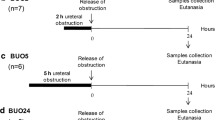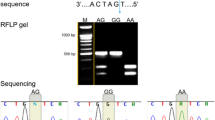Abstract
URAT1 and GLUT9 are two primary urate transporters involved in the renal urate handling. Renal urate underexcretion was reported in uric acid stone formers (UASF) in previous clinical studies. The aim of this study was to investigate the clinical features and possible impact of protein expression of URAT1 and GLUT9 in renal tissues of patients with uric acid (UA) nephrolithiasis. 23 UASF, 27 patients with calcium oxalate (CaOx) stones, and 22 normal controls were enrolled in this study. Clinical data revealed that older age of onset, high plasma UA concentration, low urinary PH, and relative renal urate underexcretion were associated with UASF. By immunohistochemical or western blotting analysis, a significant increase in the relative expression quantity of URAT1 in renal tissue of UASF was found compared to patients with CaOx nephrolithiasis and normal controls. In conclusion, our results suggested that upregulated URAT1 protein expression might contribute to the relative urate underexcretion from the kidney of UASF.


Similar content being viewed by others
References
Ramello, A., Vitale, C., & Marangella, M. (2000). Epidemiology of nephrolithiasis. Journal of Nephrology, 13, S65–S70.
Mandel, N. S., & Mandel, G. S. (1989). Urinary tract stone disease in the United States veteran population II. Geographical analysis of variations in composition. Journal of Urology, 1989(142), 1516–1521.
Knoll, T., Schubert, A. B., Fahlenkamp, D., Leusmann, D. B., Wendt-Nordahl, G., & Schubert, G. (2011). Urolithiasis through the ages: data on more than 200,000 urinary stone analyses. Journal of Urology, 185(4), 1304–1311.
Shekarriz, B., & Stoller, M. L. (2002). Uric acid nephrolithiasis: Current concepts and controversies. Journal of Urology, 2002(168), 1307–1314.
Maalouf, N. M. (2011). Metabolic syndrome and the genesis of uric acid stones. Journal of Renal Nutrition, 21(1), 128–131.
Maalouf, N. M., Cameron, M. A., Moe, O. W., & Sakhaee, K. (2004). Novel insights into the pathogenesis of uric acid nephrolithiasis. Current Opinion in Nephrology and Hypertension, 13(2), 181–189.
Maesaka, J. K., & Fishbane, S. (1998). Regulation of renal urate excretion: A critical review. American Journal of Kidney Diseases, 1998(32), 917–933.
Enomoto, A., Kimura, H., Chairoungdua, A., Shigeta, Y., Jutabha, P., Cha, S. H., et al. (2002). Molecular identification of a renal urate anion exchanger that regulates blood urate levels. Nature, 417(6887), 447–452.
Hediger, M. A., Johnson, R. J., Miyazaki, H., & Endou, H. (2005). Molecular physiology of urate transport. Physiology (Bethesda), 2005(20), 125–133.
Preitner, F., Bonny, O., Laverrière, A., Rotman, S., Firsov, D., Da Costa, A., et al. (2009). Glut9 is a major regulator of urate homeostasis and its genetic inactivation induces hyperuricosuria and urate nephropathy. Proceedings of the National Academy of Sciences of the United States of America, 2009(106), 15501–15506.
Lipkowitz, M. S. (2012). Regulation of uric acid excretion by the kidney. Current Rheumatology Reports, 14(2), 179–188.
Ichida, K., Hosoyamada, M., Hisatome, I., Enomoto, A., Hikita, M., Endou, H., et al. (2004). Clinical and molecular analysis of patients with renal hypouricemia in Japan-influence of URAT1 gene on urinary urate excretion. Journal of the American Society of Nephrology, 2004(15), 164–173.
Matsuo, H., Chiba, T., Nagamori, S., Nakayama, A., Domoto, H., Phetdee, K., et al. (2008). Mutations in glucose transporter 9 gene SLC2A9 cause renal hypouricemia. American Journal of Human Genetics, 2008(83), 744–751.
Yü, T., & Gutman, A. B. (1967). Uric acid nephrolithiasis in gout. Predisposing factors. Annals of Internal Medicine, 67(6), 1133–1148.
Terkeltaub, R., Bushinsky, D. A., & Becker, M. A. (2006). Recent developments in our understanding of the renal basis of hyperuricemia and the development of novel antihyperuricemic therapeutics. Arthritis Research & Therapy, 8(Suppl 1), S4.
Negri, A. L., Spivacow, R., Del Valle, E., Pinduli, I., Marino, A., Fradinger, E., et al. (2007). Clinical and biochemical profile of patients with “pure” uric acid nephrolithiasis compared with “pure” calcium oxalate stone formers. Urological Research, 35(5), 247–251.
Sekine, T., Miyazaki, H., & Endou, H. (2006). Molecular physiology of renal organic anion transporters. American Journal of Physiology-Renal Physiology, 290(2), F251–F261.
Knoll, T., Schubert, A. B., Fahlenkamp, D., Leusmann, D. B., Wendt-Nordahl, G., & Schubert, G. (2011). Urolithiasis through the ages: data on more than 200,000 urinary stone analyses. Journal of Urology, 185(4), 1304–1311.
Krambeck, A. E., Lieske, J. C., Li, X., Bergstralh, E. J., Melton, L. J, 3rd, & Rule, A. D. (2013). Effect of age on the clinical presentation of incident symptomatic urolithiasis in the general population. Journal of Urology, 189(1), 158–164.
Goldfarb, D. S., Parks, J. H., & Coe, F. L. (1998). Renal stone disease in older adults. Clinics in Geriatric Medicine, 14(2), 367–381.
Reynolds, K., & He, J. (2005). Epidemiology of the metabolic syndrome. American Journal of the Medical Sciences, 330(6), 273–279.
Kadlec, A. O., Greco, K., Fridirici, Z. C., Hart, S. T., Vellos, T., & Turk, T. M. (2012). Metabolic syndrome and urinary stone composition: What factors matter most? Urology, 80(4), 805–810.
Cho, S. T., Jung, S. I., Myung, S. C., & Kim, T. H. (2013). Correlation of metabolic syndrome with urinary stone composition. International Journal of Urology, 20(2), 208–213.
Daudon, M., Lacour, B., & Jungers, P. (2006). Influence of body size on urinary stone composition in men and women. Urological Research, 34(3), 193–199.
Parvin, M., Shakhssalim, N., Basiri, A., Miladipour, A. H., Golestan, B., Mohammadi Torbati, P., et al. (2011). The most important metabolic risk factors in recurrent urinary stone formers. Urology Journal, 8(2), 99–106.
Moreira, D. M., Friedlander, J. I., Hartman, C., Elsamra, S. E., Smith, A. D., & Okeke, Z. (2013). Using 24-hour urinalysis to predict stone type. Journal of Urology, 190(6), 2106–2111.
Chen, G. L., Zhu, L. R., Na, S., & Li, L. (2013). Effect of total saponin of dioscorea on chronic hyperuricemia and expression of URAT1 in rats. Zhongguo Zhong Yao Za Zhi, 38(14), 2348–2353.
Kimura, T., Amonpatumrat, S., Tsukada, A., Fukutomi, T., Jutabha, P., Thammapratip, T., et al. (2011). Increased expression of SLC2A9 decreases urate excretion from the kidney. Nucleosides, Nucleotides & Nucleic Acids, 30(12), 1295–1301.
Acknowledgments
We thank Urology of Emergency Medical Center of Chongqing, China for providing renal samples. This study was supported by the Natural Science Foundation of Chongqing Science and Technology Commission (Chongqing, China; Grant No. 2011BA5011).
Author information
Authors and Affiliations
Corresponding authors
Rights and permissions
About this article
Cite this article
Fu, W., Li, Q., Yao, J. et al. Protein Expression of Urate Transporters in Renal Tissue of Patients with Uric Acid Nephrolithiasis. Cell Biochem Biophys 70, 449–454 (2014). https://doi.org/10.1007/s12013-014-9939-y
Published:
Issue Date:
DOI: https://doi.org/10.1007/s12013-014-9939-y




